More work needed on Gurlitt art trove, says task force

More work is needed to confirm the past of hundreds of works of art hoarded by collector Cornelius Gurlitt, experts said on Thursday. Germany’s culture minister pledged to try to get to the bottom of where they all came from.
A special task force that has been checking Gurlitt’s trove – more than 1,200 works found at his Munich apartment, plus around 250 from his property in Salzburg, Austria – submitted its final report on Thursday after two years’ work. Gurlitt died in 2014, months after German authorities said they had seized the works in Munich.
In his will, Gurlitt named the Bern Museum of Fine Arts sole heir of the collection.
Gurlitt’s father, Hildebrand, was an art dealer who traded in works confiscated by the Nazis. Experts ruled out 507 works from the Munich collection having been looted under Nazi rule but have been looking at the provenance of hundreds more.
So far, only five works have been conclusively identified as having been looted from Jewish owners, among the 13 works on which all research has been completed. Jewish groups have criticised the German effort.

More
When owning works of art isn’t black and white
In an interview with swissinfo.ch in November, Berlin-based journalist Catherine Hickley, author of The Munich Art Hoard: Hitler’s Dealer and His Secret Legacy, said: “The whole bureaucracy involved in actually conducting the restitutions has been just dreadfully slow and dreadfully obstructive. So the claimants have all got incredibly frustrated by that.”
Jewish criticism
Research will be continued by the government-backed German Lost Art Foundation. Senior task force member Andrea Baresel-Brand is to lead the ongoing effort.
“The German government’s aim remains to clear up the provenance of all the pictures that were in Cornelius Gurlitt’s possession,” Culture Minister Monika Grütters said.
Baresel-Brand said more work is needed to clear up questions about the past of 672 works. In 162 cases, there are indications that works were looted. There have been 118 claims on a total of 104 works.
The head of the World Jewish Congress, Ronald Lauder, said the results so far were “meagre and not satisfactory”. He criticised the task force for a lack of transparency and said in a statement that he “expected Germany to do better, given that time is running out”.
Grütters said officials had faced an unprecedented challenge in the Gurlitt case. She said she understood both art historians’ difficulties in tracing back works over decades and the impatience of victims of Nazi persecution and their heirs.
“We will not be spared this experience in the future either: the experience that speed and thoroughness in provenance research can’t be had at the same time,” she said.

In compliance with the JTI standards
More: SWI swissinfo.ch certified by the Journalism Trust Initiative













You can find an overview of ongoing debates with our journalists here . Please join us!
If you want to start a conversation about a topic raised in this article or want to report factual errors, email us at english@swissinfo.ch.